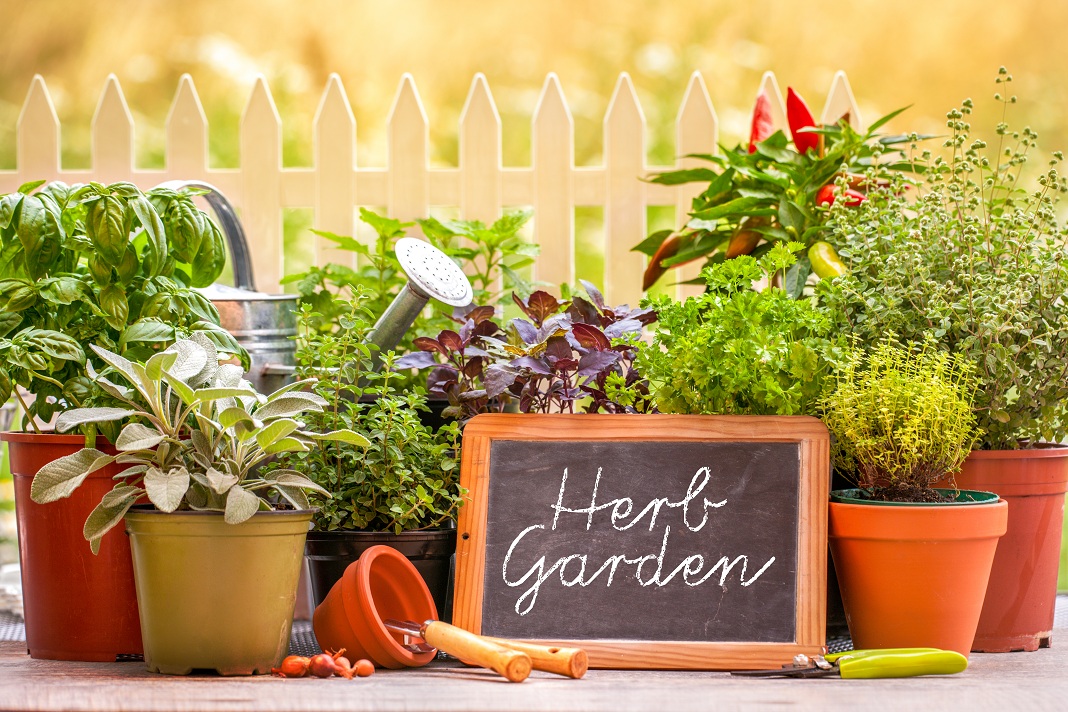 Herb gardening is an ideal way to utilize sunny areas, backyard, and balconies of a house. Home or herb gardening is also a great way to de-stress, relax, and enjoy something that eventually gives you organic benefit. Even with a plot as small as 4 square foot, you can grow herbs of your choices, feed your family, and freeze it for later.
Herb gardening is an ideal way to utilize sunny areas, backyard, and balconies of a house. Home or herb gardening is also a great way to de-stress, relax, and enjoy something that eventually gives you organic benefit. Even with a plot as small as 4 square foot, you can grow herbs of your choices, feed your family, and freeze it for later.
Unlike vegetable and fruit gardening, starting a herb garden is not difficult. A little bit of planning is required. And that is all – no extensive digging, no fertilizing and all that patching and everything else that go in real gardening. You could even grow certain herbs indoor. If you are on this page, then sure you have a passion for herbs and gardening and you would probably like to know more. So, here we are with a complete guide on how to start a herb garden at home.
Step 1: Plan your Herb Gardening Project
You have to start with a plan and determine what kind of herbs you would like to grow. What should be the purpose of growing? Culinary herbs are those that go into dishes. They can be grown in your kitchen window sill or balcony. It is absolutely a great idea for home-chefs and people who like cooking with herbs. Although most culinary herbs have medicinal properties, you can start a medicinal herb garden for treatment purposes. However, you need to study more about medicinal herbs and their uses and learn how they are supposed to be used before you start the garden.
Step 2: Choose Your Site
Once you have decided your reason behind herb gardening, the main requirement for growing herbs is growing them in the correct location. The sun and moisture are two important requirements when you choose your location. Some herbs thrive well in full sun, while others require partial sunlight, and then there are other varieties that prefer moist soil or gravelly soil. If you don’t have the right soil condition, you can create a raised bed and condition the soil accordingly to suit your herb. However, if you are a beginner, stick to the basics so that you do not spoil the entire project.
The temperature of the sun is also important. Most herbs can be grown in full sun with regular summer temperature that doesn’t rise above 90 degrees.
If you live in a place where the summers are extremely warm, consider gardening in an area where the plants receive filtered sunlight, such as under a tree. Or, you can grow them in a place where it gets sunlight in the morning and shade in the noon, something like an east-facing balcony or window sill. Your herbs should get at least 4 hours of direct sunlight, so check the site several times to determine the hours of sun.
The right growing condition will make your herbs healthy and flavourful. It may even thrive for a long period. Here is a list of herbs you can consider growing according to conditioning:
- Herbs that Require Sun: Basil, Coriander/ Cilantro, Dill, Fennel, Chamomile, Rosemary, Thyme, Oregano, and Lavender
- Herbs that are Grown in Shade or Partial Sunlight: Mint, Parsley, Cilantro (if the region is extremely warm), Lemon Balm, Chives and Chervil
- Herbs Grown in Moist Soil: Lemon Balm, Mint, Watercress, Bergamot, and Angelica
- Mediterranean Herbs (Grown in Gravelly Soil): Rosemary, Lavender, Oregano, Sage,and Thyme
For detailed information, you should consult an herb gardener or browse through herb sites, such as Healthy Living Herbs.
Make sure your herb garden is near to your kitchen for quick and easy picking. You can also grow your herbs along with your vegetables and flowers. For heavy soils, you can either use compost or consider growing your herbs in containers.
Step 3: Designing Your Herb Garden
First comes the designing part, then choosing your herbs and then planting them.
Today, the internet is flooding with interesting herb gardening ideas. Herb gardens look so beautiful, you can actually make them your home décor. There are formal herb gardens that have straight lines and geometrical structures. The area for such gardens should be either square or rectangle. Or you can stir your creativity and create an informal herb garden. Informal herb gardens usually have flowing lines and grown in aesthetic looking pots and containers. An informal herb garden can be grown anywhere in the house, as it needs less initial structuring.
Once you have chosen your design, select the herbs you want to garden. If it is for culinary purpose, choose only those herbs that you regularly use and not occasionally. You should start with five to ten herbs.
You should then divide the herbs according to their growing condition, look, and height. For instance, you can combine annual herbs together and perennial herbs together and grow them in separate containers or places.
Step 4: Preparing and Planting the Garden
Now comes preparing the garden. Remove stones, sod from the soil, and level the area. You need approximately one to four feet diameter for each plant. This ratio depends upon the type of herb as well. For instance, Cilantro, Parsley, Dill, and Chives require only 1 foot to grow, Basils and Thyme require 2 feet, and Rosemary, Mint, Sage, and Oregano require 3 to 4 feet to grow.
Digging and Composting the Soil:
Once you have measured the space, you have to start working on the soil. Most herb plants require well-drained soil. Dig the soil to a 30 cm depth, loosen it, and condition it with organic compost. Digging the ground is very important to loosen the soil that has become compact over the years. Loose ground allows water to drain and plant roots to reach the depth of the soil. If you plant on raised beds and sloping grounds drainage will be better. Compost should be added about an inch on top of the soil. You should also use fertilizers to promote good soil health and drainage. Fishmeal and bones are organic fertilizers, which you can easily get from your meals. Now leave the soil as it is for a night to settle.
Planting the Herb Seeds:
Set the herbs properly leaving enough individual space. Water your herbs well before planting. Loosen the roots with your fingers to encourage new root growth. Place the roots into their respective holes and firm the soil gently around. Once this is done, water the soil thoroughly to settle it.
Some seedlings, such as Dill, Basil, Lemon Balm grow fast into plants, while others, like Mint and Rosemary, take time to grow. So, you may want to purchase a combination of seedlings and grown plants from a nursery for even growth. Also, remember to arrange the taller plants towards the back and the shorter ones in the front.
Planting Mediterranean herbs could be little strenuous, as you need to raise a bed filled with gravelly soil, such as cactus soil blend, soil mix with fine stones, or soil mixed with crusher run stone. If you wish to grow this kind of herbs, you could ask a gardener or nursery staff to help you prepare the bed.
Step 5: Watering the New Herbs
Newly planted herb gardens require more water. However, they just need adequate water. Watering too much may loosen the soil around the roots, and hinder growth and promote plant diseases. So, do not pour liters of water on your baby plants. Water them only when the soil is dry. Water regularly and deeply.
Now, watering schedule usually changes according to the temperature and humidity. Therefore, you must check the soil to determine the water required. You could do that with your finger. Insert your index finger into the soil and check if the soil, couple of inches below the surface, is dry and flaky to touch. That is when you need to add water. Summer and dry winter climates may ask for more water.
Step 6: Growing Herb Garden in Containers
Sunny decks and balconies, patios, kitchen windowsill or a kitchen counter facing the window and other such areas are ideal for growing herbs in containers. In fact, herb containers are easier to grow and maintain. In fact, you will save a lot of digging and composting time. On the other hand, your space will be limited. However, make sure your container is large enough to hold your plants and that you place the container in a sunny and warm place.
Of course, there are pros and cons for container herb gardening. The pros are they are mobile, can be used as home decors, can be planted in attractive containers, and are easily accessible. Cons are not all herbs can be grown in containers, as they tend to grow long and prefer grounds. Plants thrive well when they are rooted in the ground, in contact with nature.
So, if you love gardening, the outdoor herb planting is the most suitable option. But, we do have successful beginners and inexpert growing plants and herbs in their kitchen and balconies. Just that you have to change the maintenance system, such as regular feeding and diligent watering.
Things You Will Require for Container Gardening:
- Large Pots: For planting herbs, you need at least 8-inch diameter for each herb to grow. Use a huge large pot, else you will have to put them in separate pots once they (such as basil) start to outgrow.
- Drainers or saucers to protect the table or deck
- Good quality potting soil
- Organic or vegetable plant fertilizers
- Watering can
The preparing, planting, and watering process are same. Follow instruction written on the packages of plant soil, fertilizers, and organic compost.
Step 7: Harvesting the Herbs Plants
Harvesting is herb plants are easier to do than many houseplants. Cut 1/3rd of the plant branches once they reach 8-inch in height. Cut the branch close to a leaf intersection to promote faster growth. Parsley and similar kinds tend to grow new leaves from the center. For such plants, remove the oldest outer branches completely. Harvesting improves with experience and time.
For instance, if the leaves appear to have a sticky formation, it means they have been attacked by an infection. If the leaves are turning pale, it means there is no adequate water in the soil and if the leaves are turning yellow, then you may have watered the plants too many a time.
9 Simple Tips for Better Herb Gardening
Try to follow these tips for a better and healthy herb gardening process.
- Make sure the area you choose is safe from your pets and birds. You don’t want your bunny or a squirrel munching your herbs all the time.
- Follow the regulations laid for gardening. For instance, gardening on fire escapes and walkable paths may not be permissible by the law in your state.
- Assess your sunlight before you decide to the garden. Your plants should receive 4 to 6 hours of adequate sunlight. If theydo not, we suggest you move the container and change direction every day so that the plants catch maximum sunrays.
- Instead of seeds, buy seedlings for fast-growing plants, and buy toddler herbs if you have a small space and a relatively short growing season. Make sure you choose only healthy plants and purchase from a reputed nursery, farmer or herb market.
- Start with the basil herb if you are a beginner. It grows enthusiastically, smells great, and tastes great. They give you plenty of first-hand gardening experience without dying out on you.
- Apart from herbs, you can also grow leafy greens in a similar Spinach, lettuce, arugula are planted and grown in the same way as herbs. They grow quickly, even after harvesting.
- You can also grow tomatoes, green chilies, and beans once you have established some knowledge.
- Mint leaves are unstoppable and grow crazily, and must have a separate pot to itself.
- Give dying plants another chance to spring up. Call the gardener and try fixing it.
We have tried to cover everything about herb gardening and added a few helpful tips. If you come across any good tips or ideas for herb gardening, do share with us in the comments below.




